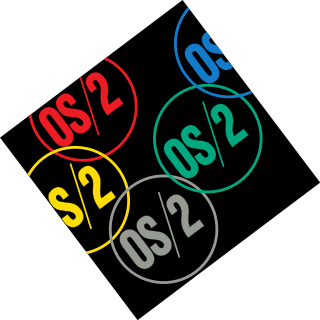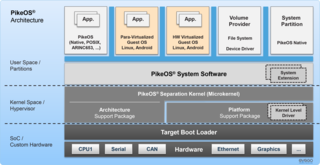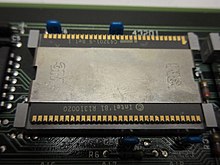The graphical user interface, or GUI, is a form of user interface that allows users to interact with electronic devices through graphical icons and audio indicator such as primary notation, instead of text-based UIs, typed command labels or text navigation. GUIs were introduced in reaction to the perceived steep learning curve of command-line interfaces (CLIs), which require commands to be typed on a computer keyboard.

The history of the graphical user interface, understood as the use of graphic icons and a pointing device to control a computer, covers a five-decade span of incremental refinements, built on some constant core principles. Several vendors have created their own windowing systems based on independent code, but with basic elements in common that define the WIMP "window, icon, menu and pointing device" paradigm.

An operating system (OS) is system software that manages computer hardware and software resources, and provides common services for computer programs.

OS/2 is a series of computer operating systems, initially created by Microsoft and IBM under the leadership of IBM software designer Ed Iacobucci. As a result of a feud between the two companies over how to position OS/2 relative to Microsoft's new Windows 3.1 operating environment, the two companies severed the relationship in 1992 and OS/2 development fell to IBM exclusively. The name stands for "Operating System/2", because it was introduced as part of the same generation change release as IBM's "Personal System/2 (PS/2)" line of second-generation personal computers. The first version of OS/2 was released in December 1987 and newer versions were released until December 2001.
Symbolics, Inc., was a privately held American computer manufacturer that acquired the assets of the former company and continues to sell and maintain the Open Genera Lisp system and the Macsyma computer algebra system.

Computer operating systems (OSes) provide a set of functions needed and used by most application programs on a computer, and the links needed to control and synchronize computer hardware. On the first computers, with no operating system, every program needed the full hardware specification to run correctly and perform standard tasks, and its own drivers for peripheral devices like printers and punched paper card readers. The growing complexity of hardware and application programs eventually made operating systems a necessity for everyday use.
Poplog is an open source, reflective, incrementally compiled software development environment for the programming languages POP-11, Common Lisp, Prolog, and Standard ML, originally created in the UK for teaching and research in Artificial Intelligence at the University of Sussex, and later marketed as a commercial package for software development as well as for teaching and research. It was one of the initiatives supported for a while by the UK government-funded Alvey Programme.

A workstation is a special computer designed for technical or scientific applications. Intended primarily to be used by a single user, they are commonly connected to a local area network and run multi-user operating systems. The term workstation has been used loosely to refer to everything from a mainframe computer terminal to a PC connected to a network, but the most common form refers to the class of hardware offered by several current and defunct companies such as Sun Microsystems, Silicon Graphics, Apollo Computer, DEC, HP, NeXT, and IBM which powered the 3D computer graphics revolution of the late 1990s.
Originally, the word computing was synonymous with counting and calculating, and the science and technology of mathematical calculations. Today, "computing" means using computers and other computing machines. It includes their operation and usage, the electrical processes carried out within the computing hardware itself, and the theoretical concepts governing them.

Sibelius is a scorewriter program developed and released by Sibelius Software Limited. It is the world's largest selling music notation program. Beyond creating, editing and printing music scores, it can also play the music back using sampled or synthesised sounds. It produces printed scores, and can also publish them via the Internet for others to access. Less advanced versions of Sibelius at lower prices have been released, as have various add-ons for the software.
The software release life cycle is the process of developing, testing, and distributing a software product. It typically consists of several stages, such as pre-alpha, alpha, beta, and release candidate, before the final version, or "gold," is released to the public.
An object-oriented operating system is an operating system that is designed, structured, and operated using object-oriented programming principles.

In computing, a visual programming language or block coding is a programming language that lets users create programs by manipulating program elements graphically rather than by specifying them textually. A VPL allows programming with visual expressions, spatial arrangements of text and graphic symbols, used either as elements of syntax or secondary notation. For example, many VPLs are based on the idea of "boxes and arrows", where boxes or other screen objects are treated as entities, connected by arrows, lines or arcs which represent relations.
VisualAge is a family of computer integrated development environments from IBM, which supports multiple programming languages. VisualAge was first released in October 1993 and was discontinued April 30, 2007 and its web page removed in September 2011. VisualAge was also marketed as VisualAge Smalltalk, and in 2005, Instantiations, Inc. acquired the worldwide rights to this product. IBM has stated that XL C/C++ is the followup product to VisualAge.
Mosaic was a Macintosh scorewriter application for producing music notation, developed by Mark of the Unicorn.

PikeOS is a commercial, hard real-time operating system (RTOS) that offers a separation kernel based hypervisor with multiple logical partition types for many other operating systems (OS), each called a GuestOS, and applications. It enables users to build certifiable smart devices for the Internet of things (IoT) according to the high quality, safety and security standards of different industries. For safety and security critical real-time applications on controller-based systems without memory management unit (MMU) but with memory protection unit (MPU) PikeOS for MPU is available.
Apple Dylan is the original implementation of the programming language Dylan. It was developed by Apple Computer from 1992 to 1995.
Abandonware is a product, typically software, ignored by its owner and manufacturer, and for which no official support is available.

MS-DOS is an operating system for x86-based personal computers mostly developed by Microsoft. Collectively, MS-DOS, its rebranding as IBM PC DOS, and a few operating systems attempting to be compatible with MS-DOS, are sometimes referred to as "DOS". MS-DOS was the main operating system for IBM PC compatibles during the 1980s, from which point it was gradually superseded by operating systems offering a graphical user interface (GUI), in various generations of the graphical Microsoft Windows operating system.








